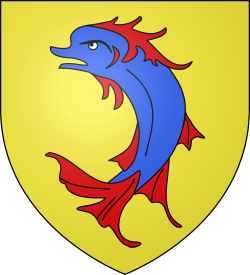List of counts of Albon and dauphins of Viennois
This article needs additional citations for verification. (June 2016) |


The counts of Albon (French: comtes d'Albon) were medieval counts of Albon in the Kingdom of Burgundy (Arles), in what is now south-eastern France. Their title was derived from the Château d'Albon.
Guigues IV, Count of Albon (d. 1142) was nicknamed le Dauphin or 'the Dolphin'. In time, his nickname morphed into a title among his successors. By 1293, the lands ruled by the counts of Albon, the old comitatus Albionis, were known as the Dauphiné of Viennois (Latin: Dalphinatus Viennensis),[1] but the city of Vienne itself was not in their possession, being governed by the Archbishops of Vienne until the middle of the 15th century.[2]
The region had been part of the Kingdom of Burgundy (Arles), since 1032 under the suzerainty of the Holy Roman Empire. In 1349, dauphin Humbert II decided to sell his domains to the French king Philip VI. The acquisition was formalized by the treaty of Romans, thus expanding the French influence beyond the river Rhône. Under provisions of the treaty, the heir apparent to the French crown shall always be titled dauphin, and he will be personal holder of those lands and titles. By condition of the emperor, the Dauphiné could never be integrated into France. When the king of France had no son, he would personally rule the Dauphiné separately, as dauphin. Thus, the province formally remained in the Holy Roman Empire even after 1349, and it was administered separately from France well into the early modern period; it was de facto incorporated into France only with the rise of absolutism in the 17th century.[3]
By the middle of the 15th century, during the reign of dauphin Louis II (future king Louis XI), counties of Diois and Valentinois were finally integrated into Dauphiné.[4]
Lords of Château d'Albon
[edit]- Guigues I of Albon the Old (c. 1000–1070), Count in Oisans, Grésivaudan and Briançonnais, Lord of Château d'Albon, ruled until 1070
- Guigues II of Albon the Fat (c. 1020–1079), Count in Grésivaudan and Briançonnais, Lord of Château d'Albon, ruled 1070–1079
Counts of Albon
[edit]- Guigues III of Albon the Count (c. 1050–1133), first Count of Albon (the southern part of the ancient County of Vienne; the northern part was granted to the first Count of Savoy), ruled 1079–1133
- Guigues IV of Albon, le Dauphin (c. 1095–1142), Count of Albon, ruled 1133–1142
Counts of Albon and Dauphins of Viennois
[edit]- Robert V, Count of Auvergne married Marquise d'Albon, a daughter of Guigues IV. Their descendants adopted the title of Dauphin of Auvergne, and it was used by some as the family name.
- Guigues V of Albon (c. 1120–1162), Count of Albon and Grenoble, Dauphin of Viennois, ruled 1142–1162
- Béatrice of Albon (1161–1228), Dauphine of Viennois, Countess of Albon, Grenoble, Oisans et Briançon, ruled 1162–1228, married Hugh III of Burgundy
- Guigues VI of Viennois (1184–1237), Dauphin de Viennois, count of Albon, Grenoble, Oisans and Briançon, ruled 1228–1237
- Guigues VII of Viennois (c. 1225–1269), Dauphin of Viennois, Count of Albon, Grenoble, Oisans, Briançon, Embrun and Gap, son of, ruled 1237–1269
- John I of Viennois (1263–1282), Dauphin of Viennois, Count of Albon, Grenoble, Oisans, Briançon and Embrun, ruled 1269–1282
- Anne of Viennois (1255–1298), Dauphine of Viennois, Countess of Albon, married Humbert, Baron of La Tour du Pin

- Humbert I of Viennois (c. 1240–1307), Baron of La Tour du Pin, Dauphin of Viennois and Count of Albon, ruled 1282–1307
- John II of Viennois (1280–1318), Baron of La Tour du Pin, Dauphin of Viennois, ruled 1307–1318
- Guigues VIII of Viennois (1309–1333), Dauphin of Viennois, ruled 1318–1333
- Humbert II of Viennois (1312–1355), Dauphin of Viennois, ruled 1333–1349
Humbert II sold his lands and titles to Philip VI of France.
Dauphins of Viennois and Dauphins of France
[edit]- Charles I of Viennois (1338–1380), also king of France as Charles V, Dauphin of Viennois, Duke of Normandy, ruled the dauphinate as the first Dauphin of France (1350–1364) and ruled the dauphinate as king of France (1364–1368)
- Charles II of Viennois (1368–1422), also king of France as Charles VI, Dauphin of Viennois, ruled the dauphinate as second Dauphin of France (1368–1380), ruled the dauphinate as king of France (1380–1386) and again during (1386–1392)
- Charles III of Viennois (1386), Dauphin of Viennois, ruled the dauphinate as third Dauphin of France (1386)
- Charles IV of Viennois (1392-1401), Dauphin of Viennois, Duke of Guyenne, ruled the dauphinate as fourth Dauphin of France (1392–1401)
- Louis I of Viennois (1397–1415), Dauphin of Viennois, Duke of Guyenne, ruled the dauphinate as fifth Dauphin of France (1401–1415)
- John III of Viennois (1398–1417), Dauphin of Viennois, Duke of Touraine, ruled the dauphinate as sixth Dauphin of France (1415–1417)
- Charles V of Viennois (1403–1461), also king of France as Charles VII, Dauphin of Viennois, ruled the dauphinate as seventh Dauphin of France (1417–1422), ruled the dauphinate as king of France (1422–1423, de facto 1457-1461)
- Louis II of Viennois (1423–1483), also king of France as Louis XI, Dauphin of Viennois, Count of Diois and Valentinois, ruled the dauphinate as eighth Dauphin of France (1423–1461), ruled the dauphinate as king of France (1461–1466)
See also
[edit]References
[edit]- ^ Bernard Bligny (1984), "Note sur l'origine et la signification du terme "dauphin" (de Viennois)", Actes des congrès de la Société des historiens médiévistes de l'enseignement supérieur public, 15e congrès, 15 (1): 155–56.
- ^ Kibler & Zinn 2016, p. 954.
- ^ Kibler & Zinn 2016, p. 52, 289-290, 420.
- ^ Kibler & Zinn 2016, p. 290.
Sources
[edit]- Kibler, William W.; Zinn, Grover A., eds. (2016) [1995]. Medieval France: An Encyclopedia. New York and London: Routledge.
